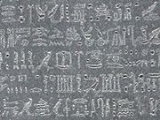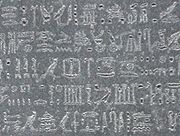
Ptolemaic Decrees
Encyclopedia
The Hellenistic Ptolemaic dynasty
, which ruled Egypt
from 305 BC to 30 BC, issued these series of decrees over the course of their reign. The Rosetta Stone
is a well-known example of one of the decrees.
The Rosetta Stone
was included in the third part of a series of three decrees, the first from Ptolemy III (the Decree of Canopus
), the second from Ptolemy IV (The Memphis Stele
), and the third from Ptolemy V
.
There are approximately two copies of the Stone of Canopus, two of the Memphis Stele (one imperfect) and two and a half copies of the text of the Rosetta Stone, including the Nubayrah Stele
and a pyramid wall inscription with "edits", or scene replacements, completed by subsequent scribes.

239 BC
The Decree was on 7 Appellaios (Mac.) = 17 Tybi (Eg.) year 9 of Ptolemy III = 7 March 238.
216 BC
196 BC
Totals: 6 stones, or stelae, 1 partial, and 1 temple wall inscription writing.
Ptolemaic dynasty
The Ptolemaic dynasty, was a Macedonian Greek royal family which ruled the Ptolemaic Empire in Egypt during the Hellenistic period. Their rule lasted for 275 years, from 305 BC to 30 BC...
, which ruled Egypt
Egypt
Egypt , officially the Arab Republic of Egypt, Arabic: , is a country mainly in North Africa, with the Sinai Peninsula forming a land bridge in Southwest Asia. Egypt is thus a transcontinental country, and a major power in Africa, the Mediterranean Basin, the Middle East and the Muslim world...
from 305 BC to 30 BC, issued these series of decrees over the course of their reign. The Rosetta Stone
Rosetta Stone
The Rosetta Stone is an ancient Egyptian granodiorite stele inscribed with a decree issued at Memphis in 196 BC on behalf of King Ptolemy V. The decree appears in three scripts: the upper text is Ancient Egyptian hieroglyphs, the middle portion Demotic script, and the lowest Ancient Greek...
is a well-known example of one of the decrees.
The Rosetta Stone
Rosetta Stone
The Rosetta Stone is an ancient Egyptian granodiorite stele inscribed with a decree issued at Memphis in 196 BC on behalf of King Ptolemy V. The decree appears in three scripts: the upper text is Ancient Egyptian hieroglyphs, the middle portion Demotic script, and the lowest Ancient Greek...
was included in the third part of a series of three decrees, the first from Ptolemy III (the Decree of Canopus
Decree of Canopus
The Decree of Canopus is a bilingual inscription in two languages, and in three scripts. It was written in three writing systems: Egyptian hieroglyphs, Egyptian Demotic, and Greek, on an ancient Egyptian memorial stone stele, the Stone of Canopus...
), the second from Ptolemy IV (The Memphis Stele
Decree of Memphis (Ptolemy IV)
The Decree of Memphis is an ancient inscribed stone stela which comprises the second of the Ptolemaic Decrees issued by Ptolemy IV of the Hellenistic Ptolemaic dynasty, which ruled Egypt from 305 BC to 30 BC. Like the Rosetta Stone, the Decree of Memphis is inscribed in three writing systems...
), and the third from Ptolemy V
Ptolemy V Epiphanes
Ptolemy V Epiphanes , son of Ptolemy IV Philopator and Arsinoe III of Egypt, was the fifth ruler of the Ptolemaic dynasty. He became ruler at the age of five, and under a series of regents the kingdom was paralyzed.-Regency infighting:Ptolemy Epiphanes was only a small boy when his father, Ptolemy...
.
There are approximately two copies of the Stone of Canopus, two of the Memphis Stele (one imperfect) and two and a half copies of the text of the Rosetta Stone, including the Nubayrah Stele
Nubayrah Stele
The Nubayrah Stele is a mutilated copy of the Decree of Memphis on a limestone stele; the same decree is found upon the Rosetta Stone...
and a pyramid wall inscription with "edits", or scene replacements, completed by subsequent scribes.

The three Decrees (the three-stone series)
Multiple copies of the stones were erected in multiple temple courtyards, as specified in the text of the decrees.239 BC239 BCYear 239 BC was a year of the pre-Julian Roman calendar. At the time it was known as the Year of the Consulship of Turrinus and Falto...
Decree of Canopus (Ptolemy III)Decree of CanopusThe Decree of Canopus is a bilingual inscription in two languages, and in three scripts. It was written in three writing systems: Egyptian hieroglyphs, Egyptian Demotic, and Greek, on an ancient Egyptian memorial stone stele, the Stone of Canopus...
, (247–221 BC)
The Decree was on 7 Appellaios (Mac.) = 17 Tybi (Eg.) year 9 of Ptolemy III = 7 March 238.- stone 1: Stele of Canopus, (no. 1), found 1866, 37 lines hieroglyphs, 74 lines Demotic (right side), 76 lines Greek 'capitals', fine limestone.
- stone 2: Stele of Canopus, no. 2Decree of CanopusThe Decree of Canopus is a bilingual inscription in two languages, and in three scripts. It was written in three writing systems: Egyptian hieroglyphs, Egyptian Demotic, and Greek, on an ancient Egyptian memorial stone stele, the Stone of Canopus...
, found 1881, 26 lines hieroglyphs, 20 lines Demotic, 64 lines Greek 'capitals', white limestone.
- 3rd partial of hieroglyphic lines (location: LouvreLouvreThe Musée du Louvre – in English, the Louvre Museum or simply the Louvre – is one of the world's largest museums, the most visited art museum in the world and a historic monument. A central landmark of Paris, it is located on the Right Bank of the Seine in the 1st arrondissement...
).
216 BC216 BCYear 216 BC was a year of the pre-Julian Roman calendar. At the time it was known as the Year of the Consulship of Varro and Paullus...
Decree of Memphis (Ptolemy IV)Decree of Memphis (Ptolemy IV)The Decree of Memphis is an ancient inscribed stone stela which comprises the second of the Ptolemaic Decrees issued by Ptolemy IV of the Hellenistic Ptolemaic dynasty, which ruled Egypt from 305 BC to 30 BC. Like the Rosetta Stone, the Decree of Memphis is inscribed in three writing systems...
, (221–203 BC)
- stone 1: Stele No. 1, found 1902, hieroglyphs, demotic, and Greek, dark granite.
- stone 2: Pithom Stele, No. II, found 1923, hieroglyphs (front), 42 lines Demotic (back), virtually complete providing almost total translation, and Greek (side), sandstone.
196 BC196 BCYear 196 BC was a year of the pre-Julian Roman calendar. At the time it was known as the Year of the Consulship of Purpureo and Marcellus...
Decree of Memphis (Ptolemy V), (203–198 BC)
- stone 1: Rosetta Stone, "Stele of Rosetta", found 1799, (remaining) hieroglyphs, 14 lines, 32 lines Demotic, 54 lines Greek 'capitals', dark granite-(granodioriteGranodioriteGranodiorite is an intrusive igneous rock similar to granite, but containing more plagioclase than orthoclase-type feldspar. Officially, it is defined as a phaneritic igneous rock with greater than 20% quartz by volume where at least 65% of the feldspar is plagioclase. It usually contains abundant...
).
- stone 2: Stele of NubayrahNoubaryaNoubarya is a town in Egypt, approximately 100 miles north of Cairo.The settlement was founded in 1987 as part of an irrigation scheme using water from the Nile....
, found early 1880's, hieroglyphs, lines 1-27 used to complete missing Rosetta Stone lines, demotic, Greek capitals, limestone.
- site 3: the Temple of PhilaePhilaePhilae is an island in the Nile River and the previous site of an Ancient Egyptian temple complex in southern Egypt...
, inscribed hieroglyphs, for Decree of Memphis (Ptolemy V), on walls, also overwritten, by scenes, and figures of humans/gods.
Totals: 6 stones, or stelae, 1 partial, and 1 temple wall inscription writing.

